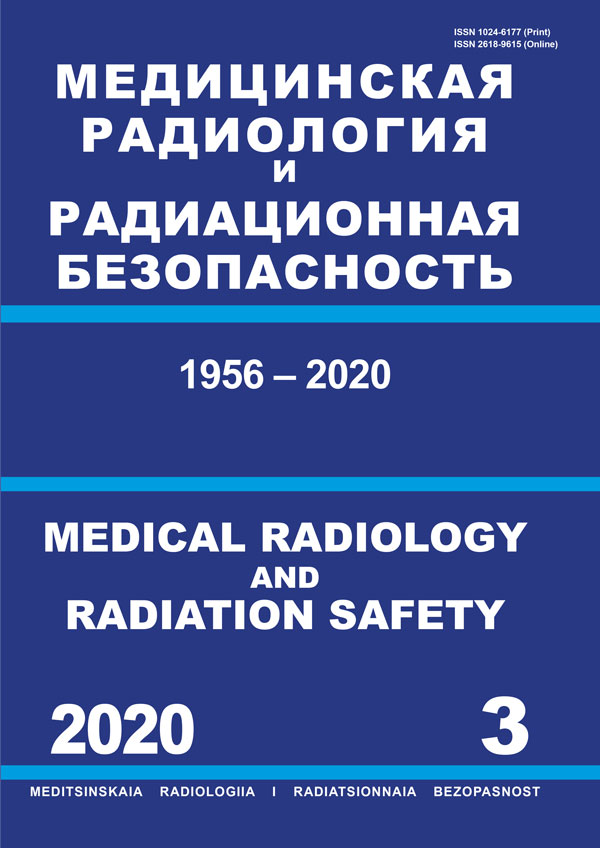Russian Federation
Russian Federation
Russian Federation
Russian Federation
UDC 61
CSCSTI 76.33
Russian Classification of Professions by Education 32.08.12
Russian Library and Bibliographic Classification 51
Russian Trade and Bibliographic Classification 5708
BISAC MED028000 Epidemiology
BISAC MED080000 Radiology, Radiotherapy & Nuclear Medicine
Purpose: Calculations of radiation detriment to the population currently living (in 2020) in the territories of Russia contaminated with 137Cs after the Chernobyl accident in 1986. Material and methods: Radiation detriment was calculated in two ways: according to the original ICRP method, and approximate calculation as the product of the nominal risk factor of RSS-99/2009 by the effective dose (nominal radiation detriment). For ICRP calculations, equivalent doses were estimated using the dose coefficients of the US Environmental Protection Agency (EPA). The number of the studied population at the beginning of 2020 was 142676 people, 65205 men and 77471 women. This is mainly the population of the Bryansk region and Tula region, 85.5 % and 10 % of the total population, respectively. The average accumulated effective dose of the population was 30.6 mSv, and the maximum individual accumulated dose was 707 mSv. Results: In 2020, for men at the age of 44 and for women at the age of 55, the nominal radiation detriment is approximately equal to the value of radiation detriment calculated using the ICRP method. At the same time, the nominal detriment is significantly (up to 2.3 times) underestimated for younger and overestimated for older ages. In 2020, the critical population groups with the highest accumulated doses and maximum radiation detriment are men aged 34 and women aged 35. For these population groups, the average accumulated effective doses were 35.3 mSv and 39.2 mSv, and the average radiation detriment was 2.6×10–3 and 4.2×10–3, for men and women, respectively. For 11.8 % of the population (8.3 % of men and 14.8 % of women), the individual radiation detriment calculated using the ICRP method exceeds the value of 3.5×10–3, which corresponds to the maximum increase in individual risk for the population over 70 years of exposure, established by RSS-99/2009 for normal exposure conditions. The maximum radiation detriment of 3.9×10–2 was found for a woman of the Krasnogorsky district of the Bryansk region at the age of 37 years, with an accumulated effective dose of 392 mSv. Conclusion: The results of this work can be used in preparing recommendations to health authorities on improving medical supervision of exposured citizens living in areas contaminated with radionuclides, as well as in developing regulatory documents for the provision of targeted medical care to people from high radiation risk groups using personalized medicine methods.
lifetime radiation risk, RSS-99/2009, Chernobyl accident, 137Cs, population of contaminated areas, radiation risk models, nominal risk coefficient
1. ICRP Publication 103. Ed by Kiselev MF, Shandala NK, Moscow. 2009. 312 p. Available from: http://www.icrp.org/docs/P103_Russian.pdf (cited 13.04.2020). (In Russ.).
2. Preston DL, Kusumi S, Tomonaga M, Izumi S, Ron E, Kuramoto A, et al. Cancer incidence in atomic bomb survivors. Part III: Leukemia, lymphoma and multiple myeloma, 1950-1987. Radiat Res. 1994;137 (Suppl.):68-97.
3. United Nations Scientific Committee on the Effects of Atomic Radiation (UNSCEAR). Sources and effects of ionizing radiation. UNSCEAR 2006 Report Vol. I, Annex A: Epidemiological studies of radiation and cancer. New York: 2008.
4. Menyajlo AN, Chekin SYu, Kashcheev VV, Maksioutov M A, Korelo AM, Tumanov KA, et al. Lifetime attributable risks from external and internal exposure to radiation: method for estimating. Radiation and Risk. 2018;27(1):5-21. (In Russ.).
5. ICRP Database of Dose Coefficients: Workers and Members of the Public; Ver. 3.0, official website. URL: http://www.icrp.org/page.asp?id=402 (date of access 19.05.2020).
6. DCAL Software and Resources. URL: https://www.epa.gov/radiation/dcal-software-and-resources (date of access 19.05.2020).
7. Health effects of Chernobyl: Prediction And Actual Data 39 Years after the Accident. Ed. by Ivanov VK, Kaprin AD. Moscow. 2015. 450 p. (In Russ.).
8. Malignant neoplasms in Russia in 2017 (morbidity and mortality). Ed by Kaprin AD, Starinskiy VV, Petrova GV. Moscow. 2018. (In Russ.).
9. Radiation safety standards (RSS-99/2009). Sanitary-epidemiological rules and standards. SP2.6.1.252309. Moscow. 2009. 100 p. (In Russ.).
10. Health risk assessment from the nuclear accident after the 2011 Great East Japan Earthquake and Tsunami based on a preliminary dose estimation. World Health Organization, 2013.
11. Preston D.L, Ron E, Tokuoka S, Funamoto S, Nishi N, Soda M, et al. Solid cancer incidence in atomic bomb survivors: 1958-1998. Radiat Res. 2007;168:1-64.
12. Ivanov VK, Karpenko SV, Kashcheev VV, Chekin SYu, Maksioutov MA, Tumanov KA, et al. Radiation risks of Russian liquidators of the Chernobyl accident for the period 1992-2017. Part I: Solid cancer incidence. Radiation and Risk. 2019;28(4):16-30. (In Russ.).
13. Ivanov VK, Karpenko SV, Kashcheev VV, Chekin SYu, Maksioutov MA, Tumanov KA, et al. Radiation risks of Russian liquidators of the Chernobyl accident for the period 1992-2017. Part II: Solid cancer mortality. Radiation and Risk. 2020;29(1):18-31. (In Russ.).
14. Radiation Protection and Safety of Radiation Sources. International Basic Safety Standards, GSR Part 3 (Interim), General Safety Requirements. Vienna: IAEA; 2015. 311 p. (In Russ.).





